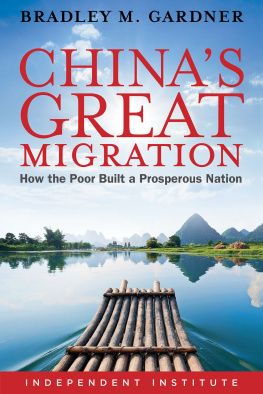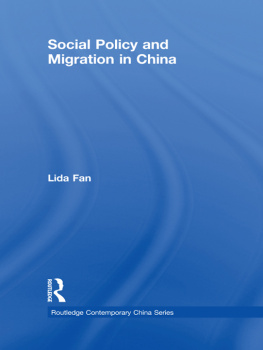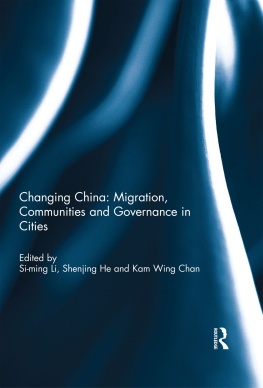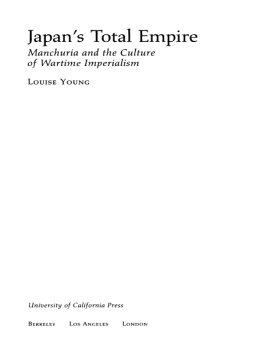SWALLOWS AND SETTLERS

SWALLOWS AND SETTLERS
The Great Migration from North China to Manchuria
Thomas R. Gottschang and Diana Lary

CENTER FOR CHINESE STUDIES
THE UNIVERSITY OF MICHIGAN
ANN ARBOR
Open access edition funded by the National Endowment for the Humanities/Andrew W. Mellon Foundation Humanities Open Book Program.
MICHIGAN MONOGRAPHS IN CHINESE STUDIES
ISSN 1081-9053
SERIES ESTABLISHED 1968
VOLUME 87
First Edition 1995
Published by
Center for Chinese Studies
The University of Michigan
Ann Arbor, Michigan 48104-1608
2000 The Regents of the University of Michigan
The paper used in this publication meets the requirements of the American National Standard for Information Sciences Permanence of Paper for Publications and Documents in Libraries and Archives ANSI/NISO/ Z39.481992.
Library of Congress Cataloging-in-Publication Data
Gottschang, Thomas R.
Swallows and settlers : the great migration from north China to
Manchuria / Thomas R. Gottschang and Diana Lary.
p. cm.
(Michigan Monographs in Chinese Studies, ISSN 1081-9053)
Includes bibliographical references and index.
ISBN 0-89264-134-7
1. Migrant laborChinaManchuria. 2. Migration, InternalChinaManchuria. 3. ChinaEconomic conditions1912-1949.1. Title: Great migration from north China to Manchuria. II. Lary, Diana. III. Title. IV. Series.
HD5856.C5 G672000
331.54409518 dc2199-086273
CIP
ISBN 978-0-89264-134-5 (hardcover)
ISBN 978-0-472-03822-0 (paper)
ISBN 978-0-472-12779-5 (ebook)
ISBN 978-0-472-90175-3 (open access)
The text of this book is licensed under a Creative Commons Attribution-NonCommercial-NoDerivatives 4.0 International License: https://creativecommons.org/licenses/by-nc-nd/4.0/
This book is dedicated to Ho Lian (Franklin Ho) and Owen Lattimore, pioneers in our field.
Contents
Tables
| Reasons for Migration |
| Landholding of Refugee Migrants |
| Disasters in Linqu, 1915-1932 |
| Locations of Ding County Migrants, 1930s |
| Ratio of Real Wages, Manchuria over North China, 1941 |
| Transportation Cost per Ton-Mile |
| Average Number of Junks Entering Port Annually |
| Major Disasters, 1891-1931 |
| Migrants from Deping, 1919 and 1934 |
| Migration Agents for Informants |
| Refugees Arriving in Jilin from Shandong, 1927-1928 |
| Postal Lines in Shandong |
| Major Currencies Circulating in Manchuria, 1929 |
| Remittances from Informants |
| Reasons for Migrants Return |
| Migrant Fares Between North China and Manchuria |
| Net Migration by Decade in Manchuria, 1950-1989 |
| Net Migration by Decade in Shandong and Hebei, 1950-1989 |
| Estimated Migration Between North China and Manchuria, 1891-1942 |
| Estimated Migration to Manchuria by Area of Origin, 1891-1942 |
| Estimated Population, 1891-1942 |
| Migrants per Thousand Population, 1891-1942 |
| Railway Freight Tonnage, 1891-1931 |
| Railway Freight Tons Per Capita of Population, 1891-1931 |
| Total Net Trade, 1891-1931 |
| Total Net Trade Per Capita of Population, 1891-1931 |
| Migration from North China to Manchuria, Return Migration, and Return Ratio, 1891-1942 |
| Migration from Hebei and West Shandong to Manchuria and Return, 1891-1942 |
| Migration from the Shandong Peninsula to Manchuria and Return, 1891-1942 |
| Population Changes in Liaoning, 1950-1989 |
| Population Changes in Jilin, 1950-1989 |
| Population Changes in Heilongjiang, 1950-1989 |
| Population Changes in Shandong, 1950-1989 |
| Population Changes in Hebei, Beijing, and Tianjin, 1950-1989 |
| Population Changes in Hebei, 1950-1989 |
| Population Changes in Beijing, 1950-1989 |
| Population Changes in Tianjin, 1950-1989 |
Figures
| Migration Between North China and Manchuria, 1891-1942 |
| Migration from the Shandong Peninsula and Hebei-West Shandong, 1891-1942 |
| Rate of Migration from the Shandong Peninsula and Hebei-West Shandong, 1891-1942 |
| Rail Freight Volume in Hebei-West Shandong and Manchuria, 1891-1931 |
| Railway Freight Tons per Capita, Hebei-West Shandong and Manchuria, 1891-1931 |
| Total Net Trade: Shandong Peninsula, Hebei-West Shandong, and Manchuria, 1891-1931 |
| Trade per Capita: Shandong Peninsula, Hebei-West Shandong, and Manchuria, 1891-1931 |
| Return Migration, 1891-1942 |
| Total Return Ratio, 1891-1942 |
| Annual Return Migration Rates by Home Area, 1891-1942 |
Maps
| North China and Manchuria: Major Railways and Cities |
| Shandong Province with Interview Sites |
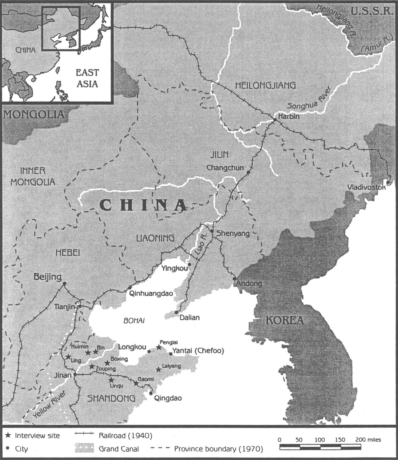
Map 1 North China and Manchuria: major railways and cities.
We generally follow Chinas official romanization system, Hanyu pinyin. Exceptions occur for people from Taiwan, Hong Kong, Singapore, and other places that use the Wade-Giles system. We have spelled peoples names the way they spell them in their own publications, including Chiang Kai-shek, who is Jiang Jieshi in pinyin. Quotations from works published in Western languages retain the romanizations used in the originals, which in some cases differ from both pinyin and Wade-Giles. A few places, like Manchuria, are familiar to readers in the English language by names that are not related to the current Chinese names; in these cases we have retained the more familiar names.
Most of the important places mentioned in this study are widely known by more than one name. We have, therefore, listed below the different names for prominent places that we encountered in the course of our research.
Manchuria is known in Chinese as either the Three Eastern Provinces (Dongsansheng) or the Northeast (Dongbei), the standard term used in China today. Manchuria is the most common term in international English language usage (e.g., the Manchurian Incident) and no longer carries the imperialist flavor that it acquired when Japanese forces created the puppet state of Manchukuo (Manzhouguo, Manchoukuo) in 1932. Manchuria also has a looser meaning, which obviates the need to change the terminology for the period of the Japanese occupation or for boundary changes that have occurred since 1949.
Liaoning, Jilin, and Heilongjiang, the three provinces of Manchuria, have taken several different forms and names over the years. During the Republican period Liaoning was usually called Fengtien, but it was also known as Shengjing (Sheng-ching, Sheng-king) and Liaodong (Liao-tung). It encompassed much of present-day Jilin (Kirin) Province, while Jilin incorporated much of the territory of todays Heilongjiang Province.
Yingkou, the first treaty port in Liaoning, was widely known in Western languages as Newchwang (Niuzhuang), which was in fact a town inland of the port where the Customs station was officially located.



